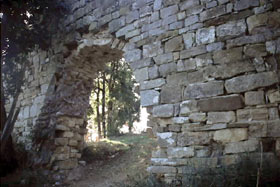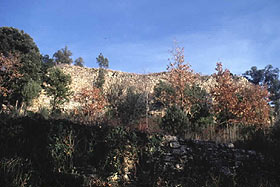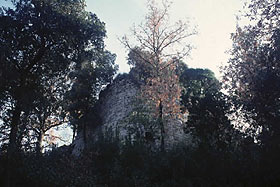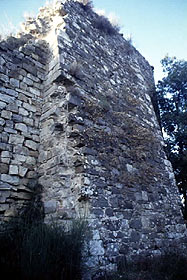Monternano Castle
 |
 |
| The main gate. | The northern curtain. |
The ruins of Monternano can be reached following a secondary, not asphalted, branch of the road SS429 della Val d' Elsa that join Poggibonsi to Castellina in Chianti. Who comes from Castellina [ from this direction is easier to identify it] find this crossroad on the right after about 6 km. and is possible to notice it thanks to the tourist signal for the Pieve di Cispiano. Pass through the above said locality and, a few hundreds meters after the road begins to slope down, turn right at the indication for La Spedda/Monternano, go forward for 1.5 km. and the road will ends near a tower house[ private property] sited just in front at the castle.
Click here for more Photos
Monternano was one of the most powerful and greatest castles of Val of Elsa, named since the 1089 in an act of donation from the Countess Mingarda di Morando to Giovanni di Benzo, then confirmed in fief to the Counts Guidi by the Emperors Arrigo VI and Frederick II. From the Guidi family it was granted to the Sienese family of the Squarcialupi, and the castle became their main stronghold.
The location of Monternano [ known also with the names of Montennano, Mortennano and Montennana], on the border between the territories of the Sienese and Florentine Republics, was of great strategical importance: in the middle of the southern crags of the mountains that from the Chianti slope down in the Val d'Elsa, over a rocky spur overlooking the stream Strolla, the castle exercised the control of two important medieval roads of communication like the Francigena, in the underlying Val d'Elsa, and the Strada di Giogoli, in the Chianti .
 |
| North West Tower. |
Together with the near town of Poggibonsi, Monternano formed an insuperable obstruction to the Florentine raids towards south. In 1201 the army of Florence attacked the castle damaging it seriously, but was in 1220, adducing the excuse that some Florentine merchants were depredated by the Squarcialupi, that the powerful rocca was stormed and shaved to the ground. In this occasion, probably, was used for the first time in Tuscany the technique of siege consisting in digging galleries under the enemy walls for mining it. Thanks to the aid of Poggibonsi and the support of the emperor, the Squarcialupi rebuilt their castle but again, in 1254, the Florentine Army, returning from the victorious siege of Monteriggioni, take the definitive control on it. Monternano was assigned to the territory of the fortified parish church of S.Agnese, one of the three churches of the 'Terzo di Castellina' that, together with the other two towns of Radda and Gaiole, formed the Lega del Chianti [Chianti League]. With the end of the wars between Siena and Florence the importance of the castle ended, mainly because of its position, useful only for military purposes, until it was abandoned.
 |
| Southern front: primitive scarped bastions. |
The castle has a rectangular shape, of great dimensions
for this zone, with the two longer sides oriented to south and north.
Today the complex is reduced to imposing ruins invaded by vegetation.
The walled circuit occupies a relief from which is possible to control
the whole Val d'Elsa.
The road leads to us directly under the eastern front , the strongest
thanks to the presence of two semi circular towers. Passing under
the one of southwest we arrive at the main gate with its
round arch still in good state of conservation. This part of the curtain
has been reinforced, probably after the siege of 1220, with the addition
of a primitive scarped basement in stone .
Entering inside the walled enceinte appear clear that
the castle was divided in two parts, the one to east, on our
right, with the feudal palace and that one to west, greater, used
for the garrison and endowed with service buildings. In the residential
area, still visible are the rests of some vaults and dungeons,
between this the great cistern.
The southern and western curtains are almost totally collapsed
while the northern is substantially intact. At the angle of northwest,
on the margin of the crag, a squared building, of which today only little
more than the foundations remain, seems to have been a watch tower. Along
the northern curtain are opened some vaulted arches, nowadays near
to be completely buried, than might been postern to access a third
outer courtyard. All along the wall are visible the holes that supported
the timber structures of the buildings that once were placed against it.
The scenographic location, the dimensions, the rapid decline that prevented
successive contamination and the quality of the survived structures made
of Monternano one of the most beautiful examples of 12th/13th century
Tuscan feudal castle.
| More Photos |
| Back to Homepage |
| Back to Castles Index |